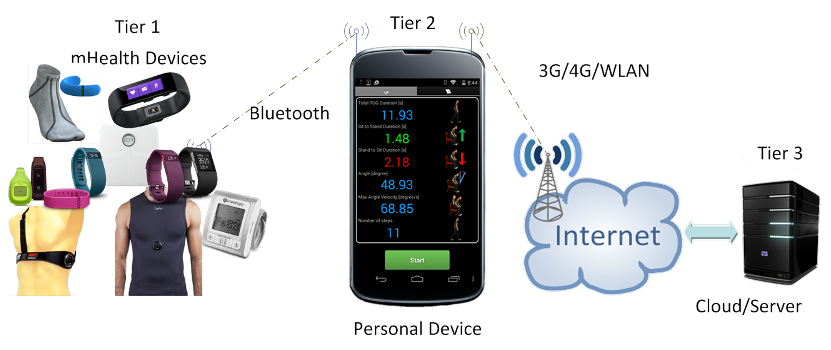The health and fitness data traffic originating on mobile devices has been continually increasing, with an exponential increase in the number of personal wearable devices and mobile health monitoring applications. Lossless data compression can increase throughput, reduce latency, and achieve energy-efficient communication between personal devices and the cloud. This paper experimentally explores the effectiveness of common compression utilities on mobile devices when uploading and downloading a representative mHealth data set. Based on the results of our study, we develop recommendations for effective data transfers that can assist mHealth application developers.
Relevant publications: [HealthCom'15b]
mHealth System Architecutre
- Tier 1: mHealth devices - a Bluetooth-eanbled embedded computers with sensors
- Tier 2: Personal device - paired with mHealth devices
- Tier 3: Personal device connects via the Internet to a mHealth Server
Data Sets:
- Recorded life bits from Zephyr Bioharness
- 5 Daily Activity types: Sleeping, Daily Activitites, Walking, 7-min Workout, Exercising
- Singals: ECG.WAVE, BB.WAVE, ACC.WAVE, B2B.TIME, R2R.TIME, SUM.LOG
- Wide range of file sizes in CSV and binary format
Lossless Compression Utilities:
| Utility | Compression levels | Version | Notes | |
| 1 | gzip | -6 | 1.6 | DEFLATE (Ziv-Lempel, Huffman) |
| 2 | lzop | -6 | 1.03 | LZO (Lempel-Ziv-Oberhumer) |
| 3 | bzip2 | -9 | 1.0.6 | RLE+BWT+MTF+RLE+Huffman |
| 4 | xz | -6 | 5.1.0a | LZMA2 |
Findings:
-
Upload: Use low-complexity utilities (e.g., lzop); do not compress data with R2R and B2B time intervals
-
Download: Use utilities that achieve a good compression ratio and speed (e.g., gzip, xz)
-
Type of monitored activity impacts the effectiveness of the compression utilities

